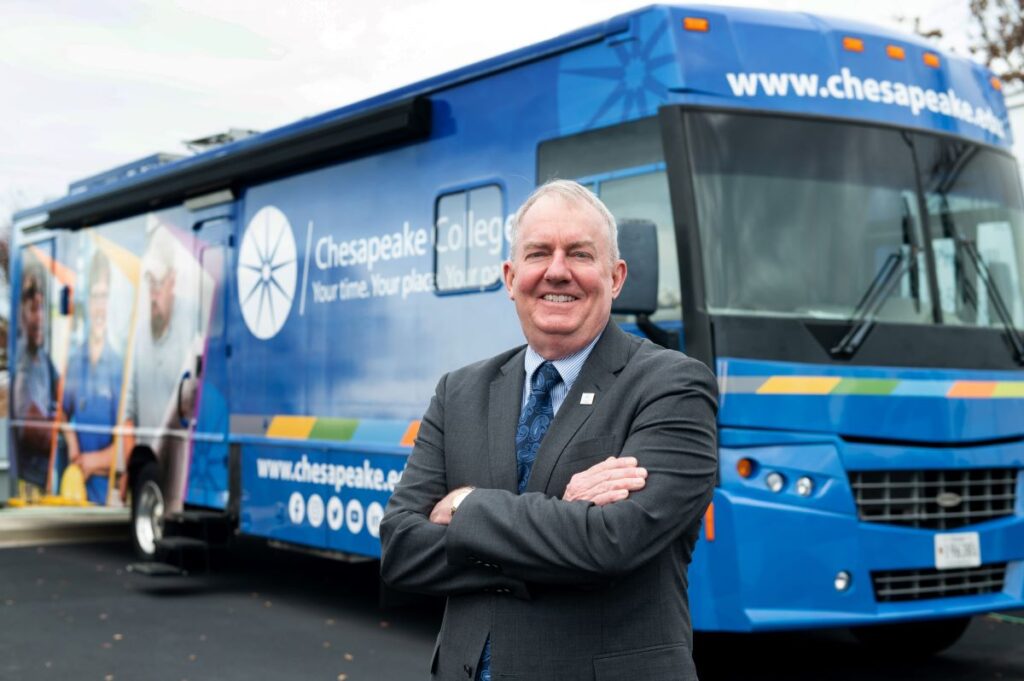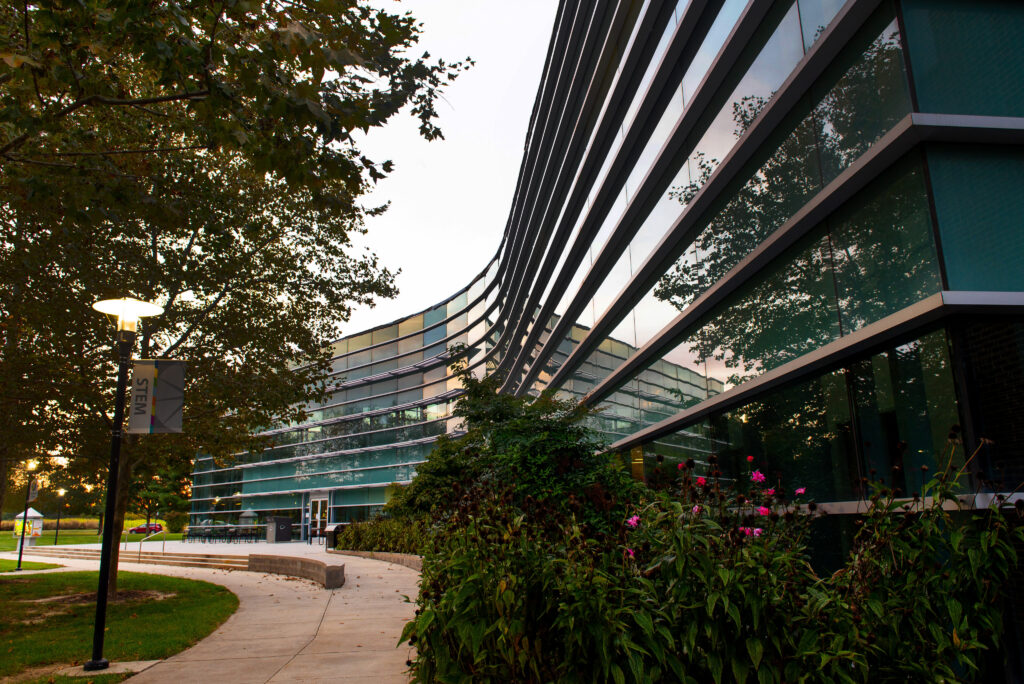Chesapeake College Meets the Challenge of Training Tomorrow’s Workforce

The “college in the cornfield” has come of age. Founded in 1965 as Maryland’s first regional community college, Chesapeake College serves Caroline, Dorchester, Kent, Queen Anne’s, and Talbot counties. For years, the college has focused on preparing students to transfer to four-year universities, but in recent years programming has expanded to include more skilled trades. The changing demographics of today’s workforce have increased the need for technical degrees and certificate programs, and Dr. Cliff Coppersmith says Chesapeake College stands poised to meet the challenge of training tomorrow’s workforce.
____________________________________
A college education isn’t just a four-year degree anymore.

These days, there are a myriad of opportunities for young people to chart their own course when it comes to careers and educational opportunities, and Chesapeake College stands poised to meet the challenge of training tomorrow’s workforce on the Eastern Shore.
Founded in 1965 as the state’s first regional community college, Chesapeake College serves Caroline, Dorchester, Kent, Queen Anne’s, and Talbot counties. For years, the college has focused on preparing students to transfer to four-year universities, but the tide is beginning to turn. The changing demographics of today’s workforce have increased the need for technical degrees and certificate programs.
“There’s a crisis brewing, and it’s a national trend,” says Cliff Coppersmith, president of Chesapeake College. “The average tradesperson is in their late 50s, early 60s, and they’re telling me there’s nobody coming on behind them.”
In recent years, the U.S. has seen a dramatic decline in skilled trade workers. The view that success requires a college degree has helped cause the exodus from vocational education, as has the lack of understanding about the opportunities available to those who choose to pursue a trade. Community colleges are quickly changing to meet this demand.
“We’re in the middle of this huge re-emphasis on skilled trades professions,” Coppersmith says. “The whole community college world is shifting. Its kind of ‘Back to the Future.’ We’re going back to workforce training, which is where we were in the 1950s and ’60s. Many community colleges really started as vocational schools.”
The growing burden of student debt coupled with the reality that a college education may not be enough to land a job has contributed to the new focus on skilled trades. Further, research shows that skilled trades workers often are more financially prosperous than their academically trained counterparts.
“Up through the late 1990s and early 2000s, the mantra was get kids a college degree,” Coppersmith explains. “That meant liberal arts degrees or the professions — teaching, business, pre-med, pre-law. If you earned a degree in history or social sciences, you could end up really prepared for something. Today, a liberal arts degree may not be enough. There is a demand for skills along with a general education background.”
Degreed Programs Still Dominate

The pandemic and the resulting workforce shortages may have turned the spotlight on non-credit workforce programs, but Coppersmith says community colleges cannot afford to lose focus on their for-credit programs.
Chesapeake College offers degree-yielding programs that range from education and health care to business and environmental studies. High school students are eligible for dual enrollment as early as the 10th grade, and classes are offered both online and in person. The college also offers continuing education courses for professional advancement.
“For-credit is still where the bulk of our budget comes from in terms of state revenue,” Coppersmith explains. “We’re funded on FTE, which is credit. That includes things like our for-credit nursing, EMT, and radiation technology programs, which are obviously workforce-focused programs.”
Because most college professors and instructors took the four-year route, Coppersmith believes educators have a natural bias. To many, college means achieving a four-year degree, not learning to work with your hands. The mantra was to get kids to college, which typically meant a four-year degree. Community colleges did the first two years, and students could transfer and finish.”
“For those of us in this business, we have to reckon with and rectify that kind of natural bias that many professionals in education have for the four-year path,” Coppersmith continues. “Those of us who’ve seen the other side and have embraced the other side realize that there are lots of opportunities for very smart kids to do things with their hands and have a great life, a great career.”
There are other reasons the skilled trades may have taken a back seat in these academic centers. Lab facilities and equipment can be costly, and the hands-on nature of the instruction requires a small class size. It’s also hard to compete with the private sector for instructional talent.
“The bottom line is that workforce programming is expensive,” Coppersmith explains. “You can only put so many students in the cab of a truck. It’s the same thing with nursing. Class sizes must be small.”
Entrepreneurship in the Trades
Still, opportunity abounds. Under Coppersmith’s leadership, Chesapeake College has expanded its definition of workforce training to include entrepreneurship. Coppersmith says he encourages young people to consider all their options when they are planning their futures.
“I think opportunities for self-employment are just enormous in the trades,” Coppersmith observes. “I encourage young people to consider entrepreneurship as a possibility, particularly if they want to live here on the Eastern Shore. You can be headquartered here and still be working in a region with all kinds of opportunities, whether it’s government contracts, state-level contracts, or working in residential services.”
In addition to the pathway as a journeyman where a skilled tradesman works for someone else, ample opportunities are available for tradespeople to eventually own and operate a business. The demand for HVAC services, electricians, welders, and truck drivers will only continue to rise.
“It’s always interesting to be in a room full of high school students, counselors, and teachers, and you tell them what the income potential is for a skilled journeyman in any of the trades,” Coppersmith says. “Obviously it takes great work ethic and a level of skill to get there, but the income potential for a motivated person is very good.”
Coppersmith believes Chesapeake College should be a hub of resources for entrepreneurs. He hopes to create a center for entrepreneurship to support business success as these tradespeople move into owning their own businesses.
“We know there’s a very high risk of failure, particularly for skilled trades folks,” he says. “We want to help skilled tradesmen make that transition and be more successful. I just think that we could be positioned to provide that ongoing resource for current students, returning students, community members, and employers.”
A Bright Future
When Coppersmith looks out his window overlooking the campus, he doesn’t see a “college in the cornfield” as Chesapeake College was once known. He sees an anchor institution on the Eastern Shore with a huge economic impact. Today, the college employs more than 250 full-time staff, with another 400 working part time. Though the future looks bright now, Coppersmith says the pandemic could very well have been the end of the road.
Revenue bottomed out as the institution went dark for six months, with employees working from home and students participating only in online classes. The Governor’s Emergency Education Relief (GEER) Fund, a part of the CARES Act passed by Congress, kept the lights on until students could return. Gov. Hogan allocated $10,000,000 of the Maryland GEER Fund to community colleges.
“The GEER Fund literally saved our bacon,” Coppersmith admits. “We were working remotely for almost six months. But GEER funding really kept the doors open for us and gave us a buffer while we recovered. We’re still in the middle of a recovery and we’re very healthy this semester.”
As he looks to the future, Coppersmith says Chesapeake College will continue to respond to the needs of the community. The college is partnering with other organizations and offering more programming at satellite locations in the five counties.
“If you want to go to school where there’s non-credit or for-credit programs, short term or longer term, there are all kinds of resources right now,” Coppersmith says. “We can provide the skill sets our students need to build the foundation for America, whether it’s health care or welding or residential and commercial construction.”
_____
Chesapeake College will host a Spring Open House at the Cadby Theatre on the Wye Mills Campus on April 26 from 6-7:30 p.m. For more information, visit chesapeake.edu.
